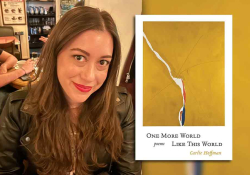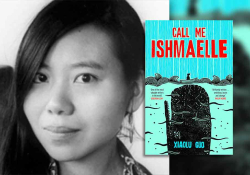Uncanny Japanese Noir: Uketsu’s Strange Pictures

Strange Pictures (HarperVia, 2025) is the first book released in English by the mysterious and cryptic best-selling Japanese author Uketsu. This mystery-horror novel spans multiple decades and creates a unique identity for itself from the first page, incorporating pictures into this larger mystery. Upon finding a blog containing cryptic pictures and a foreboding final entry, Shuhei Sasaki becomes a piece of a much larger puzzle. The reader is shuttled between the different timelines, being introduced to a string of murders that will slowly unravel the mystery of this blog and uncover the secret message its author, using the pseudonym Raku, has hidden within.
 A large part of understanding this book involves understanding its author. Completely anonymous, he is only ever referred to as Uketsu. Apart from the fact he is a Japanese man, little is known about his personal life, as he only ever makes appearances wearing all black with a white papier-mâché mask, completely obscuring his appearance. He began this persona on YouTube in 2018 and in 2020 posted a video that was a short story of a mystery based on the floor plans of a house. After receiving recommendations to turn it into a novel, he did, thus spawning his literary career with his first book, Strange Houses. While Strange Pictures (his second book) makes use of many different kinds of pictures, Strange Houses’s entire mystery revolves around floor plans. As we see with Strange Houses, Uketsu seems to enjoy the unconventional use of visuals in his stories. In Strange Pictures, this works to make the book stand out from any other mystery novel I’ve read. The usage of pictures isn’t noticeable just because of the novelty of it but also due to how well they are incorporated into the mystery; they’re vital to the plot, and there would be no Strange Pictures without the pictures.
A large part of understanding this book involves understanding its author. Completely anonymous, he is only ever referred to as Uketsu. Apart from the fact he is a Japanese man, little is known about his personal life, as he only ever makes appearances wearing all black with a white papier-mâché mask, completely obscuring his appearance. He began this persona on YouTube in 2018 and in 2020 posted a video that was a short story of a mystery based on the floor plans of a house. After receiving recommendations to turn it into a novel, he did, thus spawning his literary career with his first book, Strange Houses. While Strange Pictures (his second book) makes use of many different kinds of pictures, Strange Houses’s entire mystery revolves around floor plans. As we see with Strange Houses, Uketsu seems to enjoy the unconventional use of visuals in his stories. In Strange Pictures, this works to make the book stand out from any other mystery novel I’ve read. The usage of pictures isn’t noticeable just because of the novelty of it but also due to how well they are incorporated into the mystery; they’re vital to the plot, and there would be no Strange Pictures without the pictures.
Uketsu introduces the book talking about how analyzing a picture can reveal hidden secrets, and perhaps a glimpse into its artist’s psyche and emotional state. This introduction works perfectly to prime the reader to feel a sense of agency in the story. Since we are told that pictures contain hidden truths, we begin inspecting every one we come across. You feel as though you are figuring the plot out alongside the characters. This, however, is just a feeling. In actuality, most of the time you are waiting for the character to put the pieces together for you and analyze the pictures. This isn’t entirely a bad thing, as there’s still enjoyment to be found in trying to outsmart the characters. Not all of the pictures are pieces of evidence in the mystery, with some being there to help the reader understand what’s happening, such as showing the layout of an apartment hallway to show how close a woman’s pursuer is to her room. These non-evidence pictures were drawn digitally, rather than the hand-drawn pictures that are a part of the story and are vital pieces of evidence. I typically found these digital drawings to be welcome, as they succeeded in helping me follow along, such as when a character would manipulate a picture to reveal a hidden secret.
The strangeness of this book does not stop with its use of pictures but extends to the plot’s nonlinearity as well.
The strangeness of this book does not stop with its use of pictures but extends to the plot’s nonlinearity as well. The story is constantly jumping between decades, with seemingly no connection between each plot. Slowly, however, you start to piece two timelines together, and then another one begins to connect, until you finally realize exactly how everything in the book is connected. Near the end, however, the characters do begin making some leaps in logic that are just beyond plausibility. The motivations of some of the characters lack depth at best, and are lazy at worst. That said, these individual details don’t detract from the overarching plot, since it works so well as a cohesive piece.
Despite the violent subject matter, Uketsu still finds time in the plot to have some really sad and touching moments. What strikes me in particular is how effortless Uketsu makes it seem. The narrative is not introduced as being one that will tug on your heartstrings, but it ends up so. The subplots as well can bring you to tears. They don’t require much setup either, sometimes being created and resolved within the same chapter. This all comes together to, in a way, transform the story by the end. The murder mystery never stops being the main focus, but by the end, we’ve seen the emotions and experiences of many of the characters, which leads to an entirely different view of the mystery. This integration of emotion and mystery turns what would otherwise just be a mystery book making clever use of pictures into an experience that keeps you thinking about it much longer after you’ve finished it.
Coming in at 236 pages and with the many pictures throughout, Strange Pictures is a pretty quick read, facilitated by Jim Rion’s smooth translation, particularly of the dialogue. Given that somewhat small length, Uketsu is still able to craft what feels like a grandiose mystery that will surprise you with its emotional depth. His next book to appear in English, Strange Houses, is the initial mystery novel that propelled Uketsu into literary fame in Japan and is set to release June 3, 2025.
University of Oklahoma















